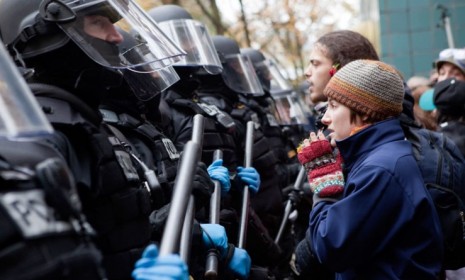Police vs. Occupiers: How dangerous is pepper spray?
The controversial crowd-control weapon is dozens of times hotter than a jalapeno, and can cause temporary blindness for up to 30 minutes

After police at UC Davis caused a national uproar by using pepper spray on peaceful student protesters, Fox News host Megyn Kelly dismissed the crowd-control weapon as "a food product, essentially." That's not quite right. How dangerous is pepper spray? Here's what you should know:
What's in pepper spray?
Pepper spray relies on varying concentrations of a compound called capsaicin — the same substance that naturally gives peppers their notorious heat, and makes "habaneros so much more formidable than the comparatively wimpy bells," says Deborah Blum at Scientific American.
The Week
Escape your echo chamber. Get the facts behind the news, plus analysis from multiple perspectives.

Sign up for The Week's Free Newsletters
From our morning news briefing to a weekly Good News Newsletter, get the best of The Week delivered directly to your inbox.
From our morning news briefing to a weekly Good News Newsletter, get the best of The Week delivered directly to your inbox.
And how does pepper spray work?
The "oily" capsaicin extract used in pepper spray triggers burning sensations by "binding directly to proteins in the membranes of pain and heat" in the nervous system, says Blum. When capsaicin makes contact with the eyes, it can cause 30 minutes of temporary blindness, and "induces a burning sensation... by damaging cells in the outer layer of the cornea." When pepper spray touches the skin, it can cause tingling, intense burning pain, swelling, redness, and sometimes blistering, says Katherine Hobson at The Wall Street Journal. Contact with the respiratory system is the most dangerous, says Hobson. It can cause swelling and inflammation of the air passages — a serious risk to asthmatics or people with other breathing conditions.
When can police use pepper spray?
Officers are permitted to use pepper spray as a "compliance tool," says Charles J. Kelly, a former Baltimore police lieutenant who wrote his department's use of force guidelines. Indeed, pepper spray is often preferable to using batons or lifting protesters up. "When you start picking up human bodies, you risk hurting them. Bodies don't have handles on them."
A free daily email with the biggest news stories of the day – and the best features from TheWeek.com
What kind of pepper spray did UC Davis police use?
They employed a brand called Defense Technology, says Kyle Wagner at Gizmodo. The intensity of Defense Technology's various pepper sprays is based on "Major Capaicinoid content." The lowest concentration, 0.2 percent, is authorized for tactical deployment. A concentration of 1.3 percent is powerful enough to stop a bear. The type used on the students has a rating of 0.7 percent. The manufacturer recommends the spray be used at a minimum distance of six feet, yet the officers in this case sprayed it on sitting students at near-point blank range.
How does this pepper spray stack up against actual peppers?
Sweet bell peppers have zero Scoville Units (a heat-intensity measure named after American pharmacist Wilbur Scoville, who was the first to chart "the intensity of a pepper's burn," says Blum). Red chiles have a heat range between 500 to 750. Jalapenos sit between 3,500 and 8,000. Spicy-hot habanero peppers range between 200,000 to 350,000. And pepper spray employed by police? It ranges between 2 million and 5.3 million Scoville Units, leaving even "the most painful of natural peppers" in its dust, Blum says.
Sources: CBS, Gizmodo, Scientific American, Wall Street Journal
-
 Zootropolis 2: a ‘perky and amusing’ movie
Zootropolis 2: a ‘perky and amusing’ movieThe Week Recommends The talking animals return in a family-friendly sequel
-
 The twists and turns in the fight against HIV
The twists and turns in the fight against HIVThe Explainer Scientific advances offer hopes of a cure but ‘devastating’ foreign aid cuts leave countries battling Aids without funds
-
 Storyteller: a ‘fitting tribute’ to Robert Louis Stevenson
Storyteller: a ‘fitting tribute’ to Robert Louis StevensonThe Week Recommends Leo Damrosch’s ‘valuable’ biography of the man behind Treasure Island
-
 Has Zohran Mamdani shown the Democrats how to win again?
Has Zohran Mamdani shown the Democrats how to win again?Today’s Big Question New York City mayoral election touted as victory for left-wing populists but moderate centrist wins elsewhere present more complex path for Democratic Party
-
 Millions turn out for anti-Trump ‘No Kings’ rallies
Millions turn out for anti-Trump ‘No Kings’ ralliesSpeed Read An estimated 7 million people participated, 2 million more than at the first ‘No Kings’ protest in June
-
 Ghislaine Maxwell: angling for a Trump pardon
Ghislaine Maxwell: angling for a Trump pardonTalking Point Convicted sex trafficker's testimony could shed new light on president's links to Jeffrey Epstein
-
 The last words and final moments of 40 presidents
The last words and final moments of 40 presidentsThe Explainer Some are eloquent quotes worthy of the holders of the highest office in the nation, and others... aren't
-
 The JFK files: the truth at last?
The JFK files: the truth at last?In The Spotlight More than 64,000 previously classified documents relating the 1963 assassination of John F. Kennedy have been released by the Trump administration
-
 'Seriously, not literally': how should the world take Donald Trump?
'Seriously, not literally': how should the world take Donald Trump?Today's big question White House rhetoric and reality look likely to become increasingly blurred
-
 Will Trump's 'madman' strategy pay off?
Will Trump's 'madman' strategy pay off?Today's Big Question Incoming US president likes to seem unpredictable but, this time round, world leaders could be wise to his playbook
-
 Democrats vs. Republicans: who are US billionaires backing?
Democrats vs. Republicans: who are US billionaires backing?The Explainer Younger tech titans join 'boys' club throwing money and support' behind President Trump, while older plutocrats quietly rebuke new administration